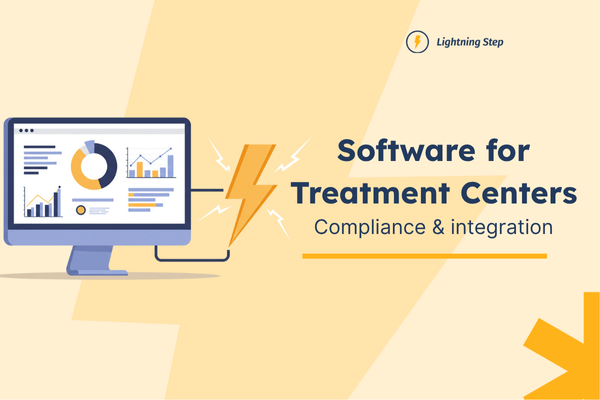
Treatment centers face mounting pressure to modernize operations while maintaining strict compliance standards. The right software can transform your clinical and administrative processes, but choosing incorrectly can lead to costly setbacks. Let's examine how to evaluate software solutions based on three critical factors: compliance capabilities, integration potential, and operational efficiency.
Digital transformation has fundamentally changed how treatment centers deliver care. Paper charts and manual processes are giving way to streamlined digital workflows that connect every aspect of patient care.
Software for treatment centers encompasses specialized tools designed to manage the unique needs of behavioral health and addiction treatment facilities. These systems handle everything from initial patient contact through treatment and billing.
The market for these solutions continues to grow. According to recent data, treatment centers that implement comprehensive software solutions report 30% faster documentation times and 25% improvement in billing accuracy. But these benefits only materialize with the right system in place.
Compliance isn't optional in healthcare. Your software must meet stringent regulatory requirements while protecting sensitive patient information.
HIPAA compliance forms the foundation of any treatment center software. This includes:
Beyond HIPAA, your software should address other relevant standards like 42 CFR Part 2 for substance use disorder records and state-specific requirements.
When evaluating compliance features, ask vendors specific questions about their security protocols. HIPAA-compliant EHR solutions should provide detailed documentation about their security measures and regular compliance audits.
Look for systems that offer role-based access controls, allowing you to limit staff access to only the information they need. This reduces risk and helps maintain proper boundaries between clinical and administrative functions.
Treatment centers typically use multiple systems to manage different aspects of their operations. Your new software must integrate with these existing tools to prevent information silos.
Key integration points to consider include:
Ask vendors about their API capabilities and pre-built integrations with popular systems. The best solutions offer robust integration options that minimize manual data transfer between platforms.
Integrating with third-party vendors allows you to maintain relationships with trusted partners while upgrading your core systems. This flexibility can make the transition to new software much smoother.
Data migration represents another critical integration challenge. Evaluate how the vendor handles transferring existing patient records and historical data. A clear migration plan with minimal disruption to operations should be a priority.
The right software dramatically improves operational efficiency across your treatment center. Look for solutions that automate routine tasks and reduce administrative burden.
Efficiency features to prioritize include:
These features directly impact your bottom line by reducing staff time spent on administrative tasks and improving revenue capture. Effortless data input capabilities allow your clinical staff to focus more on patient care and less on paperwork.
Measure potential efficiency gains by asking vendors for case studies or testimonials from similar facilities. Concrete examples of time savings and revenue improvements provide valuable benchmarks for your own implementation.
AI-powered documentation assistance represents one of the most significant efficiency advancements in recent years. Solutions that incorporate AI can reduce documentation time by up to 40%, freeing clinicians to spend more time with patients.
Beyond the core considerations of compliance, integration, and efficiency, several other factors influence the long-term success of your software implementation.
Your treatment center's needs will evolve over time. Choose software that can grow with you, accommodating:
Cloud-based solutions typically offer better scalability than on-premises systems, with easier updates and fewer infrastructure limitations.
Every treatment center operates differently. Customizable systems allow you to adapt the software to your specific workflows rather than forcing your team to change established processes.
Look for solutions that offer:
But beware of solutions requiring extensive custom development. These can become costly to maintain and difficult to update over time.
Even the best software requires reliable support. Evaluate the vendor's:
A vendor that invests in your success will provide comprehensive support throughout your relationship, not just during the initial implementation.
Use this structured approach to evaluate potential software for treatment centers:
When comparing options, create a scoring matrix that weights these factors according to your priorities. This objective approach helps prevent decisions based on flashy features rather than core functionality.
During contract negotiations, pay attention to:
Selecting the right software for treatment centers requires careful consideration of compliance capabilities, integration potential, and efficiency improvements. The decision impacts every aspect of your operation, from patient care to financial performance.
An all-in-one behavioral health EHR & EMR software solution can address many of these needs simultaneously, reducing the complexity of managing multiple systems. These comprehensive platforms often provide better integration between functions like admissions, clinical documentation, and billing.
Take time to thoroughly evaluate your options. The right software partner will not only meet your current needs but continue to innovate and support your growth for years to come.
Begin your evaluation process today by documenting your specific requirements and researching solutions designed for behavioral health and addiction treatment. Your patients and staff deserve technology that enhances care while making operations more efficient.



